Photography courtesy of Lowell Washburn, all rights reserved.
Mention the words ‘fall color’ and most people will immediately think of the red, orange, and yellow hues of an autumn woodland. But there is another brand of fall color that, although a bit more difficult to observe, is no less spectacular in its brilliance. But be forewarned. If you wish to view this unique and regal beauty for yourself, there is no time to delay. As is always the case when it comes to fall color, the time line is short; the opportunities fleeting. Blink twice and the color will vanish. You see, this unique variety of fall color has wings. By now, you’ve probably already figured out that I’m referring to a bird – a bird known as the wood duck.
The Beau Brummell of American waterfowl, the wood duck is colorful, noisy, elegant, and above all, showy. It is also one of my very favorite bird species. Everything about this unique web-foot intrigues me. Simply stated, I love to watch, photograph, hunt, listen to, and eat wood ducks. Exactly which of those categories brings me the most enjoyment is impossible to say. Now that I think about it, I guess I can’t name a single thing that I don’t like about wood ducks. The species is in a league of its own, and there’s no such thing as spending too much time around these boisterous and entertaining waterfowl.
But getting a chance to observe the species at close range doesn’t necessarily come easy. Feeling most at home in what biologists refer to as ’closed habitats’, wood ducks are shy and reclusive. Rarely found on the open waters of lakes and ponds, they instead prefer the dark seclusion of thickly wooded stream corridors, quiet river backwaters, or thickly vegetated swamplands. Getting to where they live can be plain hard work and is often best accomplished through the use of boots and machete rather than by oars or propeller.
During the day, wood ducks can be found loafing in widely scattered flocks. But at sunset, the birds move to congregate at communal roosting sites. Flooded willow thickets or isolated beaver ponds are ideal locations. For those who would watch wood ducks perform at their finest, an active roost site can provide the ultimate in high octane entertainment. The action begins as flocks of incoming wood ducks suddenly appear from all points of the compass. Etched against the blazing color of an autumn sunset, each group’s arrival is enthusiastically announced with the distinctive, screeching call of the hens. As the sun dips below the horizon, the flight intensifies. Upon reaching the roost site, incoming birds show no hesitation before conducting a high speed and breath taking decent through the tangled overhead canopy; falling like meteors as the firmament comes alive with the hiss and roar of set wings. Numbers continue to escalate until, by the onset of full darkness, upwards of 200 or more of the spectacularly colored birds may be shoe spooned into a single tiny opening in the willows. On one memorable occasion, I observed as 458 wood ducks descended to the surface of one small beaver pond during an 18 minute roosting flight. Lying atop the far end of the beavers’ dam, I was able to view the entire show at close quarters.
There’s no question that roosting flights can become exciting events. But of all the wood duck’s unique and interesting behaviors, I think I enjoy watching them forage for acorns as much as any. Acorns are a favored fall menu item for woodies. So much so, in fact, that way down in the Deep South the species is simply referred to as the ‘Acorn Duck’. Where fallen oak leaves have drifted into long wind rowed piles, I’ve seen hungry wood ducks dive in and go completely underground in search of hidden nuts. The only thing that belied the flock’s presence was a rapidly expanding network of ’mole trails’ beneath the leaves. Every now and then, a colorful head would suddenly pop to the surface as a bird struggled to swallow an unusually large acorn. In spite of their short legs and webbed feet, foraging wood ducks can travel overland at amazing speeds, swarming like fire ants across the forest floor. The larger the flock, the faster they seem to go — competition, I guess. Wood ducks are greedy and birds will eat until they can hold no more. Once flocks have eaten their fill, the birds take to the air again. With distended crops bulging like bean bags, they immediately head for their nighttime roost.
When I was a kid, I used to count the acorns that I found in the ducks I’d bagged. Sometimes the count would run well into the twenties. Lately, I’ve been washing and saving those acorns. I’ve begun planting them along the outside edge of an ancient woodlot that overlooks a secluded wetland where my friend, Ed Kotz and I hunted ducks back in the 1960s. I’m hoping that someday, my Grand Kids will sit beneath these growing oaks and stare in wonder as, etched against the blazing color of an autumn sunset, flocks of loudly screeching wood ducks come in to roost. 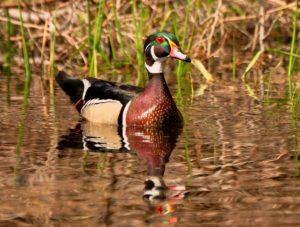

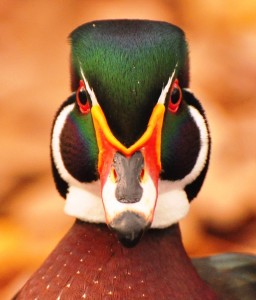
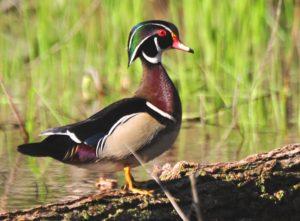
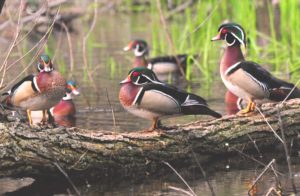
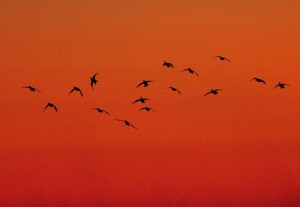
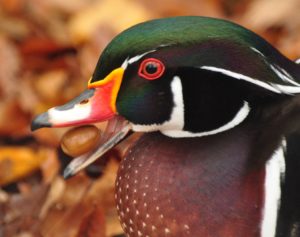
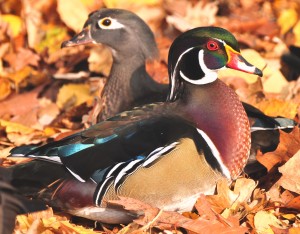
 Tom Cope
Tom Cope Sue Wilkinson
Sue Wilkinson Susan Judkins Josten
Susan Judkins Josten Rudi Roeslein
Rudi Roeslein Elyssa McFarland
Elyssa McFarland Mark Langgin
Mark Langgin Adam Janke
Adam Janke Joe Henry
Joe Henry Kristin Ashenbrenner
Kristin Ashenbrenner Joe Wilkinson
Joe Wilkinson Dr. Tammy Mildenstein
Dr. Tammy Mildenstein Sean McMahon
Sean McMahon